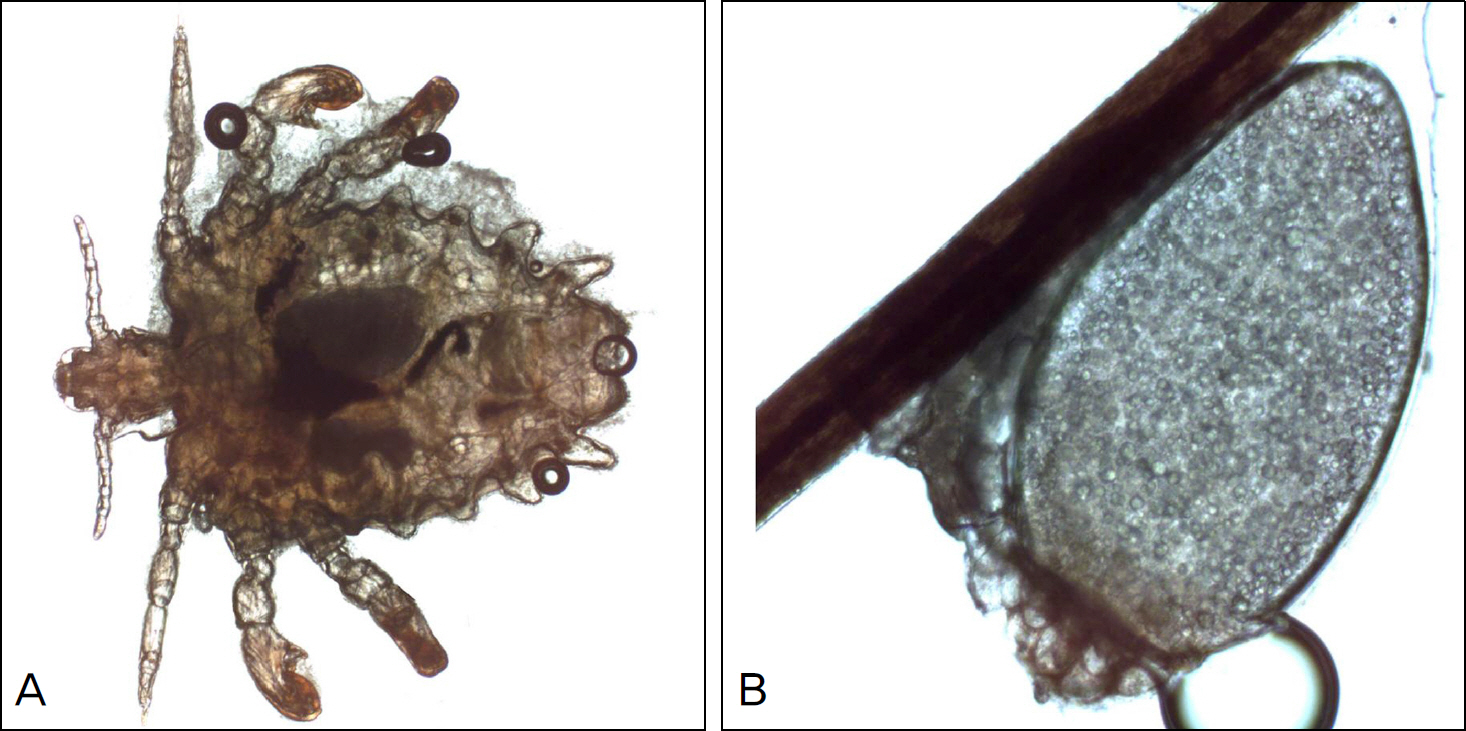J Korean Ophthalmol Soc.
2011 Oct;52(10):1222-1226. 10.3341/jkos.2011.52.10.1222.
A Case of Phthiriasis Palpebrarum Treated with Tea Tree Oil in a Child
- Affiliations
-
- 1Department of Ophthalmology, Kyung Hee Medical Center, Kyung Hee University School of Medicine, Seoul, Korea.
- 2Department of Ophthalmology, Chung-Ang University College of Medicine, Seoul, Korea. yschun100@hanmail.net
- KMID: 2215006
- DOI: http://doi.org/10.3341/jkos.2011.52.10.1222
Abstract
- PURPOSE
The authors of the present study report a case of phthiriasis palpebrarum treated with petrolatum ointment and tea tree oil in a 12-month-old boy.
CASE SUMMARY
A bluish-gray macule and blood clots were found on the central portion of the upper eyelid of a boy who had rubbed his eyelid vigorously 1 week prior. Several 0.5 mm sized brownish-gray nits and 1.6 mm sized lice on the eyelashes were visible and was diagnosed with phthiriasis palpebrarum after light microscopic examination. The nits and lice were gently removed mechanically with the help of a white petrolatum ointment (Vaseline) and the eyelashes were cleaned with 50% tea tree oil. Nits and lice were successfully eradicated without recurrence 10 days after daily treatment with petrolatum ointment and 10% tea tree oil eyelash cleansing.
MeSH Terms
Figure
Reference
-
References
1. Lee SH, Choi J-Y, Hong ST. Synopsis of Medical Parasitology. Korea Medical Book Publisher;1996. p. 461–5.2. Mansour Am. Photo essay: phthiriasis palpebrarum. Arch Ophthalmol. 2000; 118:1458–9.3. Niazi MK, Arain MA. Phthiriasis palpebrarum. J Coll Physicians Surg Pak. 2009; 19:589–90.4. Ha YC, Heo JM, Kim HJ, et al. Infestation status of head louse and treatment with lindane shampoo in children of primary school and kindergarten in Chinju-shi, Kyongsangnam-do, Korea. Korean J Parasitol. 2000; 38:41–3.
Article5. Sim S, Lee IY, Lee KJ, et al. A survey on head lice infestation in Korea (2001) and the therapeutic efficacy of oral trimethoprim/ sulfamethoxazole adding to lindane shampoo. Korean J Parasitol. 2003; 41:57–61.6. Anderson AL, Chaney E. Pubic lice (Phthirus pubis): history, biology and treatment vs. knowledge and beliefs of US college students. Int J Environ Res Public Health. 2009; 6:592–600.7. Kim HK, Kil YG, Kim IC, Kim YS. A case of Phthiriasis palpebrarum in children. J Korean Ophthalmol Soc. 1998; 39:759–62.8. Yoon KC, Park HY, Seo MS, Park YG. Mechanical treatment of Phthiriasis palpebrarum. Korean J Ophthalmol. 2003; 17:71–3.
Article9. Lee DH, Huh S, Sohn MA. A case of Phthiriasis palpebrarum. J Korean Ophthalmol Soc. 1997; 38:698–701.10. Awan KJ. Cryotherapy in phthiriasis palpebrarum. Am J Ophthalmol. 1977; 83:906–7.
Article11. Awan KJ. Argon laser phototherapy of phthiriasis palpebrarum. Ophthalmic Surg. 1986; 17:813–4.
Article12. Perlman HH, Fraga S, Medina M. Phthiriasis palpebrarum (phthiriasis ciliaris). J Pediatr. 1956; 49:88–90.13. Couch JM, Green WR, Hirst LW, de la Cruz ZC. Diagnosing and treating Phthirus pubis palpebrarum. Surv Ophthalmol. 1982; 26:219–25.
Article14. Kestoon BM. Conjunctivitis and blepharitis due to yellow mercu-ric oxide. Arch Ophthalmol. 1931; 6:581–2.15. Burns DA. The treatment of Pthirus pubis infestation of the eyelashes. Br J Dermatol. 1987; 117:741–3.
Article16. Rundle PA, Hughes DS. Phthirus pubis infestation of the eyelids. Br J Ophthalmol. 1993; 77:815–6.
Article17. Burkhart CN, Burkhart CG. Oral ivermectin for phthiriasis palpebrum. Arch Ophthalmol. 2000; 118:134–5.19. Kumar N, Dong B, Jenkins C. Pubic lice effectively treated with Pilogel. Eye. 2003; 17:538–9.
Article20. Vandeweghe K, Zeyen P. Phthiriasis palpebrarum: 2 case reports. Bull Soc Belge Ophtalmol. 2006; 300:27–33.21. Charfi F, Ben Zina Z, Maazoun M, et al. Phthiriasis pubis palpebrarum in children. Diagnosis and treatment. J Fr Opthalmol. 2005; 28:765–8.22. Halcon L, Milkus K. Staphylococcus aureus and wounds: a review of tea tree oil as a promising antimicrobial. Am J Infect Control. 2004; 32:402–8.23. Hammer KA, Carson CF, Riley TV. Antifungal effects of Melaleuca alternifolia (tea tree) oil and its components on Candida albicans, Candida glabrata and Saccharomyces cerevisiae. J Antimicrob Chemother. 2004; 53:1081–5.
Article24. Caldefie-Chezet F, Guerry M, Chalchat JC, et al. Anti-inflammatory effects of Melaleuca alternifolia essential oil on human polymorphonuclear neutrophils and monocytes. Free Radic Res. 2004; 38:805–11.25. Walton SF, McKinnon M, Pizzutto S, et al. Acaricidal activity of Melaleuca alternifolia (tea tree) oil: in vitro sensitivity of sarcoptes scabiei var hominis to terpinen-4-ol. Arch Dermatol. 2004; 140:563–6.
Article26. McCage CM, Ward SM, Paling CA, et al. Development of a paw paw herbal shampoo for the removal of head lice. Phytomedicine. 2002; 9:743–8.
Article27. Mills C, Cleary BJ, Gilmer JF, Walsh JJ. Inhibition of acetylcholi-nesterase by Tea Tree oil. J Pharm Pharmacol. 2004; 56:375–9.
Article28. Gao YY, Di Pascuale MA, Li W, et al. In vitro and in vivo killing of ocular Demodex by tea tree oil. Br J Ophthalmol. 2005; 89:1468–73.
Article29. Perrett CM, Evans AV, Russell-Jones R. Tea tree oil dermatitis associated with linear IgA disease. Clin Exp Dermatol. 2003; 28:167–70.
Article30. Khanna M, Qasem K, Sasseville D. Allergic contact dermatitis to tea tree oil with erythema multiforme-like id reaction. Am J Contact Dermat. 2000; 11:238–42.



